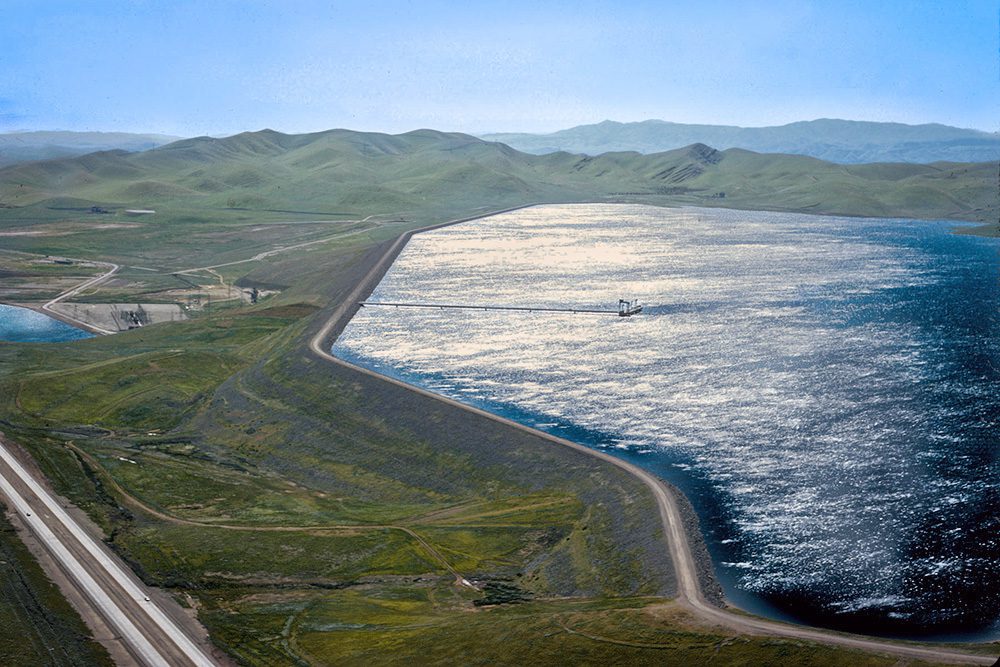- 130,000 acre-feet of new water storage capacity planned for San Luis Reservoir.
- First major water storage project approved in California since 2011.
- Federal funding reaches $95 million to date.
- Expansion benefits millions of people, farmland, and wildlife habitats.
November 14, 2024 — In a move to bolster California’s water resources, the Bureau of Reclamation and the San Luis & Delta-Mendota Water Authority announced yesterday a consensus agreement for the B.F Sisk Dam Raise and Reservoir Expansion Project
announced yesterday a consensus agreement for the B.F Sisk Dam Raise and Reservoir Expansion Project . The joint initiative will add 130,000 acre-feet of storage space to the San Luis Reservoir, enhancing water supply for over two million people, more than one million acres of farmland, and 135,000 acres of Pacific Flyway wetlands and critical wildlife habitats.
. The joint initiative will add 130,000 acre-feet of storage space to the San Luis Reservoir, enhancing water supply for over two million people, more than one million acres of farmland, and 135,000 acres of Pacific Flyway wetlands and critical wildlife habitats.
A Milestone in California Water Management.
This project marks the first approval of a major water storage project in California since 2011, following the signing of the Record of Decision by Reclamation on October 20, 2023. “I’m thrilled to be here today with our state and local partners to make this important project a reality,” said Bureau of Reclamation Commissioner Camille Calimlim Touton . “Projects move at the speed of trust, and we are so proud of these partnerships that allow us to work together to meet our mutually beneficial goals on behalf of the communities we serve.”
. “Projects move at the speed of trust, and we are so proud of these partnerships that allow us to work together to meet our mutually beneficial goals on behalf of the communities we serve.”
The agreement includes significant provisions such as cost sharing and space management for both federally-funded and authority-funded portions of the expanded reservoir. To date, federal contributions amount to $95 million in construction costs, sourced from the Bipartisan Infrastructure Law and the Water Infrastructure Improvements for the Nation Act.
Leveraging Existing Projects for Greater Impact.
Previously, the Bipartisan Infrastructure Law provided over $100 million to the B.F. Sisk Dam for a separate but connected project to increase the dam’s crest by 10 feet for seismic fortification. Building on this, Reclamation and project partners negotiated to add ten more feet to the dam, allowing for the expansion of the reservoir’s storage capacity. The extra space will store water for delivery to south-of-Delta water contractors and wildlife refuges, meeting existing contractual obligations without serving new demands.
“San Luis Reservoir has served as the hub of California’s water system south of the Sacramento San Joaquin Bay-Delta since its completion in 1967,” said San Luis & Delta-Mendota Water Authority Board Chair Cannon Michael . “The ability to capture more water in the years it is available, particularly given California’s dynamic hydrology, is a critical component of a more secure future for the communities, farms, and wildlife dependent on the Authority’s member agencies for their water supply.”
. “The ability to capture more water in the years it is available, particularly given California’s dynamic hydrology, is a critical component of a more secure future for the communities, farms, and wildlife dependent on the Authority’s member agencies for their water supply.”

 .
.About San Luis Reservoir.
Located on the west side of California’s Central Valley, about 12 miles west of Los Banos, the San Luis Reservoir is integral to the state’s water infrastructure. The reservoir is impounded by the B.F. Sisk Dam, a 382-foot-high earth-fill embankment stretching over three miles. It is the nation’s largest off-stream reservoir with a current total capacity of around two million acre-feet of water. Nearby towns include Los Banos and Gilroy, and it serves as a recreational area for boating, fishing, and camping, attracting visitors from across the region. (An image of the reservoir appears in the top fold. Image via BLM
is integral to the state’s water infrastructure. The reservoir is impounded by the B.F. Sisk Dam, a 382-foot-high earth-fill embankment stretching over three miles. It is the nation’s largest off-stream reservoir with a current total capacity of around two million acre-feet of water. Nearby towns include Los Banos and Gilroy, and it serves as a recreational area for boating, fishing, and camping, attracting visitors from across the region. (An image of the reservoir appears in the top fold. Image via BLM .)
.)
What’s in Store.
The expansion of the San Luis Reservoir is seen as a crucial step in enhancing water reliability for California’s communities, agriculture, and wildlife. “Reaching this moment is a testament to the strong commitment to addressing the critical issue of water security in the state,” said Westlands Water District General Manager Allison Febbo . “Water storage is vital for the state, and this project stands to benefit millions of Californians, thousands of acres of farmland, and vital wildlife habitats.”
. “Water storage is vital for the state, and this project stands to benefit millions of Californians, thousands of acres of farmland, and vital wildlife habitats.”
Valley Water Chief Executive Officer Rick Callender added, “Investing in water infrastructure, including surface storage, is needed now more than ever to become more drought resilient.”
As California continues to face challenges with water management amid climate variability, projects like the San Luis Reservoir expansion represent collaborative efforts to secure water resources for current and future needs.

